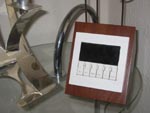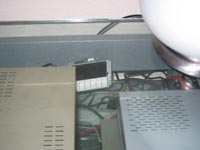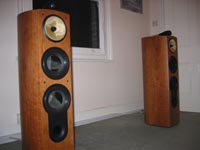
Page update coming soon with new Linn Klimax Solo 500 Pictures.
I'm a Linn man these days. After a few years of flirting with Naim equipment and having various mini systems dotted around the place for music in every room, I decided that it was finally time to buy my dream hifi system, and over the course of about three years have gone from a one room Classik system to a fully fledged Linn Knekt Multiroom installation. Now as you might know, these things don't come cheap, so I bought much of my Knekt equipment second hand from a lovely gentleman in Reading who had stripped out a large installation for a businessman returning to America.
|
With a bit of bribery I managed to get hold of Linn's Knekt software for the PC, as I figured it couldn't be that hard to install myself, rather than paying the fifty or so pounds an hour that qualified installers charge. In the interests of sharing a good thing, if you want a pointer to someone you can speak to to get said software then please drop me a line. And, right enough, it is pretty easy to tinker about and get the installation you want. The theory behind Knekt is that you have a master system on which you spend as much money on as you possibly can, and you run balanced audio from this system out to the "rooms", where you install remote amplification and a control unit, which Linn call an RCU, pictured right in a nice wooden box supplied by Graham's Hifi. The beauty of the cabling is that it runs over standard CAT-5 which is now down to around ten pence a metre from my local cable sources, Videk. Once you establish connectivity, using the Linstall package to tell the RCU what it should be controlling is fairly easy. You tell it about the remote system, tell it about any local sources that may be in the room, tinker with some cutesy little screensavers, give it a name, and that's just about it. Once done, you can independently control the volume in that room and control any sources from the master system.
| 
|
As I said, the equipment can be pricey. If bought from new, you would be looking at around £1,000 per room excluding speakers, and the array of methods in which you can connect everything together is quite bewildering at first. At the room end of the CAT-5 you need four components:
- A line receiver to convert the balanced audio feed back to line level
- A power amplifier to amplify the signal for the speakers
- An RCU to control the whole shebang
- A pair of speakers of your choice
However, this doesn't necessarily mean four separate boxes. Linn provide a number of solutions here, integrating most combinations of the electronics. The Linn Room Amp is a little black box designed to be hidden out of sight which houses a power amplifier and a line receiver. Connect up an RCU and away you go. The Linn Direktor (now discontinued for reasons to be explained later) houses all three components in a standard Linn Chassis, i.e. a line receiver, an RCU and a power amplifier. These look like a Classik without a CD tray. Or for the fully separate route, the line receiver just converts the audio and provides a pre-out for you to add amplification of your choice. This may all seem a little over-complex, but I have a combination of all this kit in different rooms around the house and it works perfectly for differing reasons.
When you think about it, it was incredibly lucky that all the different equipment I bought second hand is so perfectly matched to what I needed. There's only one room where I could have specified a slightly better solution. So, disregarding the sources, which I will come to later, here's what I bought:
- One Linn Wakonda with sneaky line driver
A preamplifier which has an extra board installed to provide four balanced audio outputs to provide Knekt to four remote rooms.
- One standalone Line Driver
A small black box which provides a further four balanced audio outputs to up the number of rooms available to eight - the maximum in a Line Driver Knekt System.
- One standalone Line Receiver
An even smaller black box which recieves and converts the balanced audio to line level audio, and provides a pre-out for external amplification.
- Two Linn Direktors
A standard Linn chassis which contains a 2x20 watt power amplifier, an RCU, and a line receiver for balanced audio conversion.
- Two Room Amps
A black box designed to be hidden away, which contains a line reciever for conversion and a 2x20 watt power amplifier. Control is managed by the addition of a wired RCU, again, a simple CAT-5 cable. These boxes are what can make Knekt Installations so elegant, as all you need to see is a pair of speakers and an RCU.
- Four RCU's
These are the brains behind any Knekt system. You need an RCU in every room you install into in order to send remote commands back to the main system.
I figured that to purchase all this new would come to somewhere in the region of £7,000. But thanks to Linn's policy of not letting people install the equipment themeselves (they don't make the Linstall package publicly available), there is no real second hand market for Knekt equipment except through authorised dealers. I picked it all up for £2,500. The RCU's alone, new, would have cost me nearly £2,000. A veritable bargain, methinks.
Over the past year - a year in which I have also moved house - I tinkered with bits and pieces and added rooms here and there. It was only when we moved in May that I realised it would finally possible to wire every room in the house for sound; the old place was a shared house with too many people in it to make it feasible, but when living with one other, it became a possibility. My final luxury was completed in December when I finished off installing equipment into the bathroom. As I mentioned, the various deployment options have worked very well for me and all rooms have the setup I would like it to have. Here's how it all fits together:
Kitchen
| In here you can see I have a Room Amp hidden on top of the kitchen units, and a pair of Classik Unik loudspeakers, one at each end of the shelving. An RCU in a backbox completes the system on the kitchen surface. A pair of Classik Unik speakers purchased from Graham's Hi-Fi also sit on top of the units. I particularly like this room install as the sound is almost invisble, i.e. the only equipment you can see is the very elegant Linn speakers and an RCU. There's always something nice about sound coming from above you in a room as well, which makes for a relaxing backdrop when working in the kitchen. |  |
Dining Room
Living Room
|
The Living Room was a whole different ballgame, as it already contains a pretty serious home cinema setup, therefore amplification and speakers were already in place. This is where my standalone Line Receiver was used. The Line Receiver converts the balanced audio and sends it at line level to my Denon KAVC-A1SE. The speakers in here are Kef THX Reference home cinema speakers and were obviously in situ before we started. I also hid an RCU away in the equipment as shown in the picture - it's never touched, but it acts as a remote sender for commands to the main system. A few minutes on Pronto Edit, and we had multiroom music in the living room. One caveat however; it sounds dreadful, purely because the Kef THX Reference Speakers are in no way designed to make music sound anything like as good as it should do. However, as background noise it's not too bad.
|  |
Bathroom
Study
Bedroom
At the source end, again, there is an array of options. The most basic source is what I began with - a Linn Classik-K which has four balanced audio outs which can be connected to either four more Classiks or to the Knekt equipment I mention above. The disadvantage of this is that every room has to listen to the same source, i.e. if I was listening to a CD in the music room, my girlfriend wouldn't be able to listen to the radio in the kitchen: she would have to listen to the CD as well. There are two ways round this - add local sources to the rooms (messy solution) or lose the Classik and go to a fully fledged Knekt setup. Well, you can guess what I did.
Here's where the dream of spectacular hi-fi truly came alive for me. In the original Classik-K driven setup I had one external LK140 power amplifier and a pair of B+W DM603s3 speakers. To cheer myself up in the summer, I struck a good deal with Musical Images in Covent Garden and snapped up the complete set source equipment. For the princely sum of £2,900 I got hold of a CD player, a second amplifier, and a tuner. This makes the complete source electronics list look like this:
Linn Ikemi
Linn's best CD player in the vaguely affordable price range. At £2,000 it's nowhere near cheap, but certainly cheaper than the wonderful CD12 which comes in at an astonishing £12,000. I personally think the law of diminishing returns for CD players has kicked in already at two grand, but it was notably better than the £1,000 Genki, which although a fine CD player (my father owns one), didn't have the detail or warmth I was looking for. It's a bit picky with scratched CDs but the build quality is excellent, and feed it a well recorded HDCD and it really shines.
Linn Pekin
Linn's only standalone tuner these days, the Pekin is a very good FM/AM receiver. We live only a few miles from the Crystal Palace transmitter so I can get a perfect 50 strength signal with just an indoor aerial. Particularly competent with spoken word and classical music, it's the perfect source for radio and is used mostly in the remote rooms.
Linn Wakonda
The odd one out of the bunch this because it's in the standard Linn dark grey colour rather than silver. I tried to get the chassis colour changed but Linn were charging a ridiculous £300 pounds for the privelige, so I'm on the lookout for a second hand Kairn Pro in silver, or even perhaps a new Exotik or Klimax Kontrol. There's no great hurry for me as I'm generally very happy with the sonic performance of the pre-amp, but it would be nice in the future.
2 x Linn LK140 Power Amplifiers
The ultimate in understated design, the LK140s only have a power button and a light on the front panel. They provide about 95 watts a channel into an 8 Ohm load, and they're bi-amped so one is feeding the treble and the other is feeding the bass and midrange. Again, I could go further with these amplifiers and the speakers would handle it, but the next level up in the Linn range is the Klimax which is beginning to look very pricey. I've considered non-Linn products at the power amp stage having read up on some of the Chord equipment, but that would required more outlay on racks and so forth. I'm happy at the moment.
Bowers and Wilkins Nautilus 803
Now these really are the babies. A recent addition having been lusted after for nearly three years, I got these in December 2002 and they're really starting to settle in now. They're big beasts, but the absolute control and forceful image they provide is quite astonishing. Bass actually has a "note" rather than just a feel, as it should do. And the treble is extremely sweet, not sounding harsh even at pretty high volumes. I had my first "cabinetless" phenomeneon a while ago when I played "The End of the Affair" by Russell Malone, a beautifully recorded Jazz piece with a variety of instruments. By closing your eyes, I completely lost any feeling of being in front of a pair of speakers, almost seeing the band in front of me. Absolutely spectacular. In the picture below, you can see that they look beautiful in a natural wood finish, and even people who claim to be unable to hear the difference between hifi sounds have been awestruck with the noise these things can produce. Wonderful.

All of the electronics is housed on a Cosmic Stand manufactured by Ash Designs, which is extremely well built and looks the business as well. Coming in at around £400, they're not cheap, but it really helps the hifi look less of a pile of electronics and more of an object that you'd wish to display.
The Future
Well, it's been something of an expensive year in the Hi-fi world for me. In 2002 I bought an entire Knekt Multiroom system, the whole high end source, and a pair of Nautilus speakers. Once I start, I just can't seem to stop myself from finishing it quicker than I anticipated. Still, it has given me the sense that I've just about hit the right point on the law of dimishing returns curve. To get a significantly better CD player I'd have to be spending well in excess of £3,000, and I wouldn't be gaining much from it. The tuner is extremely good and there is no need to upgrade. I may just look at amplification as some point, perhaps to look at some non-Linn equipment that is known to work well with Nautilus speakers, but this has logistical problems of rack space and storage. And I am on the lookout for a second hand pre-amp in silver, be it another Wakonda or a Kairn, just so the whole rack is silver. I'm loathe to buy new as I know Linn will be bringing out new pre-amps in the near future.
But apart from that there's very little I'm lusting after at the moment. When summer comes I think I'll use one of the remaining multiroom out ports to wire the roof terrace for sound. This will require a bit of thought with regards to safety as I will have to get power outside and also maybe have some equipment there. I was thinking of getting a waterproof box made with a perspex front into which I could put a Direktor, which would then be controllable with the standard IR remote. Add in a pair of B+W's all weather speakers mounted to the wall and we could have sound outside, a luxury on a par with music in the bathroom. That's definitely a summer job though, so I have a few months to think about that yet.
Until then, I'll just relax and make the most of sound in every room. We had a party over Christmas with around sixty people crammed in here, and the debauchery of being able to walk from room to room and hear the DJ mixing everywhere was something special.
So many thanks to Linn for designing such an elegant and genuinely enhancing product. If anyone would like to chat about anything in this document, or would like any help or advice with regards to Linn Knekt, then feel free to mail me and we can talk it through.